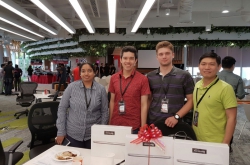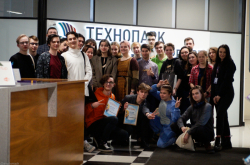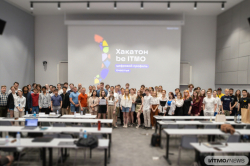The hackathon was organized by the Bezgraniz Couture company that develops functional and fashionable clothing and accessories for people with disabilities, and SAP, the world’s leading corporate software developer. In two days, participants were to come up with and develop a technological fashion project using design thinking methods as well as IoT, AR, AI technologies and predictive analysis. For that purpose, they participated in special workshops by experts from the British Higher School of Art&Design, IT developers and polymers specialists from the Covestro company. The event was conducted at the SAP Labs in Moscow with the finals taking place during the Open Innovations forum in Skolkovo. Potential customers - people with different disabilities - also took part in the hackathon.
A team of seven ITMO students succeeded in finalizing a prototype of a smart shoe that would be great for not just people with disabilities, but also pregnant women, the elderly and just anyone who has problems with putting on shoes. The shoe is a “slip-on” - it has a thick sole and no lacing; the front part can be pulled out on a rack utilizing an embedded mechanism. The mechanism can be turned on with a smartphone using a special app. To put the shoes on, users simply have to put their foot on the sole and use the app to activate the mechanism; the app also provides swipe and voice control options for those with limited hand function.
 ITMO's team at the hackathon
ITMO's team at the hackathon
ITMO’s team also added heating to their shoe: for that purpose, they’ve fixed the sole with a common heated footbed and a temperature sensor - the heating turns on automatically if the wearer’s leg temperature falls below normal. This is a very relevant function, as many people with disabilities lack sensitivity in their legs and don’t know whether they are freezing or not. As of now, there’s only one sensor per leg, but in future, the developers plan to fix sensors both in the shoe’s front and back.
At the SAP D-shop laboratory, the students printed their shoe from PLA-plastic on a 3D-printer, and cured it with textiles - covert cloth and fleece provided by the Covestro company.
“In future, we’re planning to introduce the concept of changeable front modules of different color and shape, so that they can match different clothing; the rest of the shoe will remain as it is,” notes Evgeniya Majugina from the Department of Engineering and Computer Graphics.
For purposes of the presentation, all electronic components were displayed on a stand apart from the shoes themselves. However, in the end product all the elements will fit inside the footsole together with the battery.
 BEZGRANIZ COUTURE SAP FashionTech Hackathon
BEZGRANIZ COUTURE SAP FashionTech Hackathon
“We want to make it so that prices for our footwear wouldn’t exceed those of regular shoes. At the hackathon, we had the chance to get advice from representatives of the industry, and they told us it’s quite possible. At industrial scale, when products are mass-produced, the technologies used will pay off. We’ve also consulted an industrial designer on the materials that are most cheap and functional. We want our footwear to be OK for wearing from spring to autumn,” comments Roman Belov, a student from the Department of Computer System Design and Security.
When the team took off for the hackathon, they weren’t sure whether their idea would fit the event’s format.
“We took all we could with us, including the electronics. Among our future plans is to continue working on this project in collaboration with Bezgraniz Couture at the SAP Next-Gen Lab at ITMO University. At the hackathon, we’ve met other manufacturers and designers who are also interested in collaborating with us,” says Andrei Odintsov from the Department of Mechatronics who acted as the team’s leader.
 The team's presentation
The team's presentation
The team was brought together with support from the Center for Inclusive Education Support and supervised by Alexander Dorofeev, Director of the Convergent Innovation Center. Apart from the aforementioned, Anastasia Matveeva from the Department of Computer System Design and Security, Mikhail Kolesnikov from the Instrumentation Technologies Department, Aleksandr Sobolev from the Department of Mechatronics and Lucine Chelokyan from the Department of Computer Engineering and Design were also on the team.
The #wearABLEfuture hackathon was conducted with support from Chevron Neftegaz Inc., Covestro, Ottobock, British Higher School of Art&Design, the Project Workshops Center for Youth Innovation Creativity and Moscow State University’s innovationStudio. The hackathon is partner to the SAP Next-Gen Global Challenges Summit, which is aimed at supporting the UN Global Goals for Sustainable Development project.





